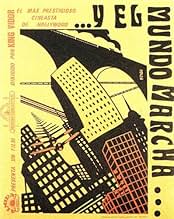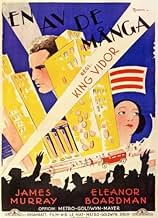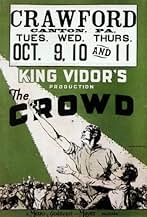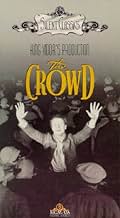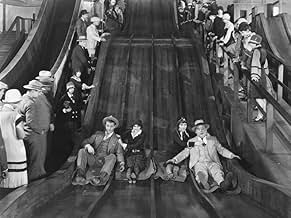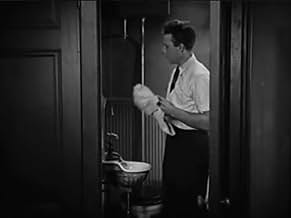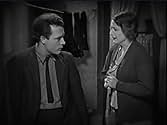NOTE IMDb
8,0/10
9,8 k
MA NOTE
La vie d'un homme et d'une femme ensemble dans une grande métropole impersonnelle à travers leurs espoirs, leurs luttes et leurs chutes.La vie d'un homme et d'une femme ensemble dans une grande métropole impersonnelle à travers leurs espoirs, leurs luttes et leurs chutes.La vie d'un homme et d'une femme ensemble dans une grande métropole impersonnelle à travers leurs espoirs, leurs luttes et leurs chutes.
- Réalisation
- Scénario
- Casting principal
- Nommé pour 2 Oscars
- 4 victoires et 2 nominations au total
John D. Bloss
- Boy on Fence
- (non crédité)
Roy Bloss
- Boy on Fence
- (non crédité)
Sidney Bracey
- John's Supervisor
- (non crédité)
Johnny Downs
- John - Age 12
- (non crédité)
Sally Eilers
- Party Girl at Bert's Place
- (non crédité)
Joseph W. Girard
- Member of Board of Directors
- (non crédité)
Pat Harmon
- Truck Driver
- (non crédité)
Chris-Pin Martin
- Worker in Hallway
- (non crédité)
Claude Payton
- Undetermined Secondary Role
- (non crédité)
Avis à la une
This wonderful silent movie depicts the individual who gets swallowed up by the uniformity of society yet also represents the yearnings and aspirations for the want of a better life. Our main character is forever waiting for his ship to come in and sadly it never does. King Vidors sweeping shot of the rows and rows of desks and the image of John being a faceless number in the crowd. Despite him thinking that he is better than others and it's only a matter of time before his situation improves. It sadly never does and he loses the respect of his wife. Perhaps if there is a moral to this movie, then it should be that life can be a bitter pill to swallow but we should take pleasure in the small things in life and recognise that we have to accept lifes disappointments which will inevitably occur. Don't let the year that the film was made put you off or it being in black and white. This movie will grab you by the throat and won't let go. A classic!
I recently watched this silent movie and I was amazed by its timelessness.
People work everyday on an eight-hour job and has dreams to make it "BIG". In that way, he could stand out of "The Crowd". Eighty years later and people still go through the same routine. Any working person can symphatize with John Sims.
In my humble opinion, the movie is a precursor of the neo-realist movies produced in Europe during the post-World War II era. The movie, in a way, also prophesied the worse: The Great Depression. John Sims, who symbolizes the common man, found it difficult landing a stable job after he quit his previous one.
A great movie, I hope this one must be watched by the viewers of today.
People work everyday on an eight-hour job and has dreams to make it "BIG". In that way, he could stand out of "The Crowd". Eighty years later and people still go through the same routine. Any working person can symphatize with John Sims.
In my humble opinion, the movie is a precursor of the neo-realist movies produced in Europe during the post-World War II era. The movie, in a way, also prophesied the worse: The Great Depression. John Sims, who symbolizes the common man, found it difficult landing a stable job after he quit his previous one.
A great movie, I hope this one must be watched by the viewers of today.
Restored with a very nice score,"the crowd" hasn't aged a bit.The topic is as relevant today as it was in 1928.Do have a look at the first pictures of "the apartment" (1960) or the last ones of "working girl"(1988)and you'll know what I mean. John Sims tries to beat the crowd,this crowd that follows him everywhere,at work,in the streets,at the fair or on the beach.He doesn't even realize his condition :you should see him laughing at the people on the street,behaving like sheep.It's always someone else,his wife says,take a look at yourself.
The secondary characters are wonderfully depicted:the well-padded buddy,the mother and brothers-in-law always contemptuous,always putting John down.Lots of sequences are memorable,now comic,now tragic:the tiny flat where even the bed must be folded,the huge office where employees are doing the same job at the same time,where everybody acts alike when they leave their job,like some kind of ballet.
John Sims is the embodiment of the American dream,but it has an universal appeal.When he was born,his father promised he would have good prospects,he would become someone big.King Vidor does not show the relationship father/son cause the father disappears when John is still a boy,but we can easily imagine it.So Sims thought NY was depending on him,and he discovers that he will be a wash-out all his life.If it weren't for his little boy who still believes in him(Vittorio de Sica will remember it for his "bicycle thief",he would throw himself under a train.
The cinematography is prodigious;two examples : The father is dead, the boy is climbing a stair : stunning high angle shot,enhancing his awful pain. On the contrary,the skyscrapers are filmed from below,showing how lost a human being can feel in this steel and glass world .
A detail :the hysterical/historical joke at the fair will be used again by the Beatles themselves in their "magical mystery tour" home-made movie.
1928:the silent era was coming to an end but we had not heard the last of it.
The secondary characters are wonderfully depicted:the well-padded buddy,the mother and brothers-in-law always contemptuous,always putting John down.Lots of sequences are memorable,now comic,now tragic:the tiny flat where even the bed must be folded,the huge office where employees are doing the same job at the same time,where everybody acts alike when they leave their job,like some kind of ballet.
John Sims is the embodiment of the American dream,but it has an universal appeal.When he was born,his father promised he would have good prospects,he would become someone big.King Vidor does not show the relationship father/son cause the father disappears when John is still a boy,but we can easily imagine it.So Sims thought NY was depending on him,and he discovers that he will be a wash-out all his life.If it weren't for his little boy who still believes in him(Vittorio de Sica will remember it for his "bicycle thief",he would throw himself under a train.
The cinematography is prodigious;two examples : The father is dead, the boy is climbing a stair : stunning high angle shot,enhancing his awful pain. On the contrary,the skyscrapers are filmed from below,showing how lost a human being can feel in this steel and glass world .
A detail :the hysterical/historical joke at the fair will be used again by the Beatles themselves in their "magical mystery tour" home-made movie.
1928:the silent era was coming to an end but we had not heard the last of it.
Skilled technique and a thoughtful approach to the lives of some ordinary characters make "The Crowd" a memorable drama that tells an interesting, if mostly downbeat, story with some worthwhile observations on human relationships. It takes skill and judgment to make a memorable movie out of this type of material, and "The Crowd" is one of numerous quality pictures from the final years of the silent era that deserve to be much better remembered.
James Murray and Eleanor Boardman are completely believable as a typical couple starting out with all kinds of dreams and expectations. As they gain increasing experience in the real world, their reactions to events, especially on Murray's part, are by no means always appealing, but they are always genuine. The characters' flaws are made clear, yet you cannot help wishing for better things for them.
The story is structured carefully, with some interesting parallels between the early scenes and the closing sequences. With only a handful of really dramatic turns, the story reveals many things about the characters that implicitly comment on human nature in general. It does not offer many solutions, but it does provide some things to think about.
The symbolism of "The Crowd" fits well with the story, and it adds another dimension to this very effective drama. The occasional camera views of the office workers and other expansive settings re-emphasize the image in a resourceful and visually striking fashion.
James Murray and Eleanor Boardman are completely believable as a typical couple starting out with all kinds of dreams and expectations. As they gain increasing experience in the real world, their reactions to events, especially on Murray's part, are by no means always appealing, but they are always genuine. The characters' flaws are made clear, yet you cannot help wishing for better things for them.
The story is structured carefully, with some interesting parallels between the early scenes and the closing sequences. With only a handful of really dramatic turns, the story reveals many things about the characters that implicitly comment on human nature in general. It does not offer many solutions, but it does provide some things to think about.
The symbolism of "The Crowd" fits well with the story, and it adds another dimension to this very effective drama. The occasional camera views of the office workers and other expansive settings re-emphasize the image in a resourceful and visually striking fashion.
Silent drama about John (James Murray) and Mary (Eleanor Boardman) meeting in NYC, falling in love and marrying. John wants to make it big--to be somebody. He looks down on those who, he feels, have failed. But, after marriage and two kids, he's still stuck in the same dead-end job and sees no way out. Then tragedy strikes and John starts to crack.
A failure when first released (it's easy to see why--it's very depressing) but now considered a masterpiece. The story is grim but the ending is happy and realistic. Murray and Boardman give superb performances (especially Murray during a scene with his son on a bridge) and King Vidor's direction is superb. The visuals in this film are decades ahead of their time. His use of the crowds and the individuals lost among them are just great.
Hard to describe but a definite must-see. Just don't expect a barrel of laughs.
A failure when first released (it's easy to see why--it's very depressing) but now considered a masterpiece. The story is grim but the ending is happy and realistic. Murray and Boardman give superb performances (especially Murray during a scene with his son on a bridge) and King Vidor's direction is superb. The visuals in this film are decades ahead of their time. His use of the crowds and the individuals lost among them are just great.
Hard to describe but a definite must-see. Just don't expect a barrel of laughs.
Le saviez-vous
- AnecdotesSeveral years after the film was made, alcoholism had taken its toll on lead actor James Murray, who was reduced to panhandling in the street. Ironically, one of the passers-by he solicited for money turned out to be King Vidor, who offered him a part in the film's semi-sequel, Notre pain quotidien (1934). Murray declined the offer, thinking it was only made out of pity. He died in 1936 at the age of 35 in a drowning incident. Vidor was sufficiently compelled to write his life story as an unrealized screenplay, which he called "The Actor".
- GaffesAfter John sprays himself with milk when opening the bottle, his clothes go from covered with milk to clean from one shot to the next.
- Citations
Title Card: The crowd laughs with you always... but it will cry with you for only a day.
- Versions alternativesThere is an Italian edition of this film on DVD, distributed by DNA srl, "LA FOLLA (1928) + LA GRANDE PARATA (1925)" (2 Films on a single DVD), re-edited with the contribution of film historian Riccardo Cusin. This version is also available for streaming on some platforms.
- ConnexionsEdited into Quand on est belle (1931)
Meilleurs choix
Connectez-vous pour évaluer et suivre la liste de favoris afin de recevoir des recommandations personnalisées
- How long is The Crowd?Alimenté par Alexa
Détails
- Date de sortie
- Pays d’origine
- Langue
- Aussi connu sous le nom de
- The Crowd
- Lieux de tournage
- Coney Island, Brooklyn, Ville de New York, New York, États-Unis(nighttime establishing exterior shots)
- Société de production
- Voir plus de crédits d'entreprise sur IMDbPro
- Durée
- 1h 38min(98 min)
- Couleur
- Mixage
- Rapport de forme
- 1.33 : 1
Contribuer à cette page
Suggérer une modification ou ajouter du contenu manquant

